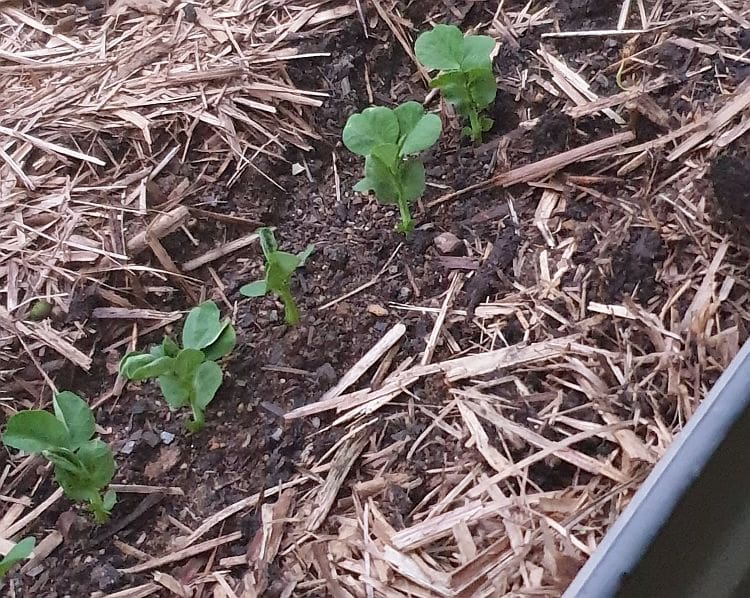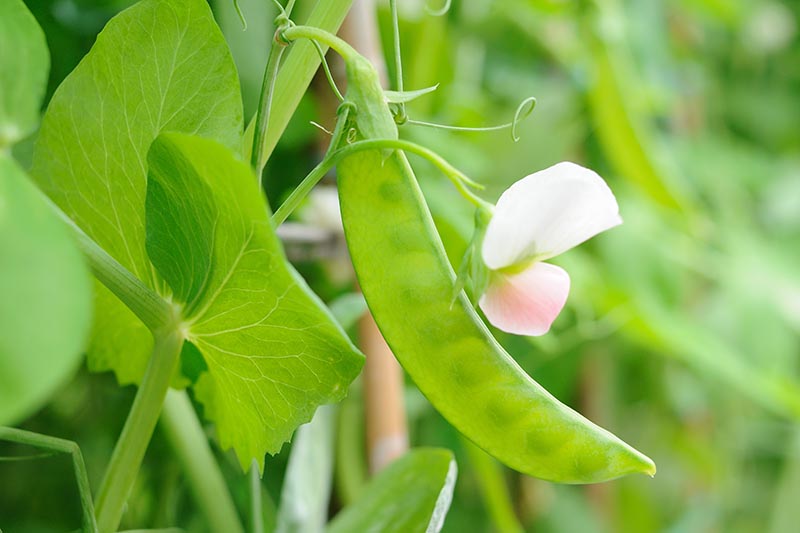Well, the saying goes, “as easy as shelling peas.” But is it really that easy to grow snow peas? If you follow my 5 top tips, you should be able to do it!
Snow peas are usually grown to eat whole, and they’re remarkably similar to sugar snap peas. In fact, sugar snap peas are a cross between snow peas and ordinary shelling peas.
Snow peas are a delight to grow and eat right from the vine. Their sweet, crisp pods add a refreshing crunch and flavor to stir fries, salads, and snack mixes. However, timing is everything when it comes to planting snow peas. This cool season crop needs to be started at just the right time to yield an abundant harvest before summer heat arrives. Read on to learn when you should plant snow peas based on your climate.
Why Timing Matters for Planting Snow Peas
Getting snow peas in the ground at the optimal time is important for several reasons:
-
Snow peas thrive in cool weather and can bolt or become stringy in heat.
-
They are frost hardy allowing for early spring planting.
-
Snow peas have a relatively short harvest window before temperatures get too hot.
-
Early planting means more time to harvest tender young pods.
-
Staggered plantings extend the harvest season for fresh peas.
-
Direct sowing avoids transplant shock that can slow growth.
While snow peas are not as finicky about planting timing as some crops, following planting guidelines for your climate will give you the most prolific harvests.
When to Plant Snow Peas
Snow peas grow best with cool air temperatures between 45-75°F (7-24°C). They can tolerate light frosts but hot weather causes bolting, poor pod set, and stringiness. Here are some general snow pea planting guidelines based on your climate:
-
In northern zones, plant 2-4 weeks before your last frost date once soil reaches 40°F.
-
In southern zones, plant in late winter or very early spring while temps are still cool.
-
Along coastal zones, plant late winter through early spring.
-
In mild climates, plant late winter as soon as soil can be worked.
-
At higher elevations, plant as soon as snow melts and soil reaches 40°F.
Aim for March to mid-April plantings across most regions. Count backwards from your average last frost to determine your timing window.
How Long Does It Take Snow Peas to Grow?
From seed to harvest, snow peas take 8-10 weeks to reach peak production. Here is a typical timeline:
-
Germination: 5-10 days. Soak seeds 24 hours before planting to speed sprouting.
-
Seedling stage: 3-4 weeks. Thin seedlings to 4-6 inches apart.
-
Vining: 3-4 weeks. Set up trellises for vines to climb once seedlings reach 4-6 inches.
-
Flowering: 6-8 weeks after planting. Flowers open for pollination.
-
Pod production: 8-10 weeks after planting. Harvest pods once they reach 3-4 inches and are still flat and tender.
-
End of harvest: 10-12 weeks after planting depending on heat and variety. Pick pods regularly to prolong harvests.
Staggering plantings every 2-3 weeks extends snow pea season considerably.
Tips for Planting Snow Peas
Follow these tips for successfully planting snow peas in your garden:
-
Direct sow seeds 1-2 inches deep in loamy, fertile soil. Space 2 inches apart in double rows or scatter patterns.
-
Soak seeds for 24 hours before planting to improve germination.
-
Consider inoculating seeds with nitrogen-fixing rhizobium bacteria to boost growth.
-
Plant on trellises, fences, or poles so vines have vertical support as they grow.
-
Use row covers at planting to protect from light frosts and early pests.
-
Amend soil with compost or organic fertilizer before planting. Side dress monthly.
-
Mulch beds to retain moisture and suppress weeds.
-
Keep soil consistently moist, watering 1-2 inches per week if rain is lacking.
With the right planting timing and care, snow peas will reward you with an abundant harvest of sweet, crispy pods all spring long.
Troubleshooting Snow Pea Planting Problems
If you encounter issues with getting your snow pea crop started, here are some potential solutions:
-
Seeds not sprouting: Ensure soil is warm enough (above 40°F) and keep moist. Soak seeds before planting.
-
Slow growth: Fertilize, check for pests, improve sunlight, and keep adequately watered.
-
Leggy or weak plants: Increase sunlight, use row covers for warmth, and provide trellising.
-
Few flowers/pods: Add more phosphorus fertilizer, attract pollinators, and avoid over-crowding.
-
Bitter flavor: Harvest pods when young and tender, around 3 inches. Overly mature peas become starchy.
With the right planting timing and care, you’ll be rewarded with a bountiful snow pea harvest. Pay close attention to the ideal planting window for your climate and provide seedlings with attentive care in their early stages.
How to Use Your Snow Pea Harvest
One of the joys of growing snow peas is using their harvest in so many delicious ways:
-
Eat young pods and shoots raw in salads and spring rolls.
-
Lightly steam or stir-fry tender pods to retain crunch.
-
Blend into smoothies, pesto, hummus, or guacamole.
-
Pickle pods or dry for storage.
-
Add pea shoots to soups, pastas, pizza, and more.
-
Use shelled peas in rice dishes, pasta primavera, pot pies, and risottos.
With their sweet flavor, crunchy texture, and versatility, snow peas are a treat to harvest and enjoy all season long.
Enjoy an Extended Harvest Through Succession Planting
Snow peas have a relatively short peak harvest period in early spring before warm weather causes bolting. But succession planting can lengthen your harvest considerably.
Stagger new plantings every 2-3 weeks from early spring through early summer. Use both early and late-bearing snow pea cultivars to extend your range. Start the latest plantings in partial shade if temps are borderline hot.
With thoughtfully timed successions, you can harvest fresh snow peas for up to 2-3 months. Track sowing dates and label plantings to help with planning.
Get a Jump Start with Indoor Seed Starting
In some climates, you can get a head start on the snow pea season by beginning seeds indoors. This allows the seedlings to get established before transplanting outside according to your last frost date.
Start seeds indoors 4 weeks before your planned outdoor planting date. Sow seeds 1 inch deep in small containers using seed starting mix. Grow under lights or a sunny window until ready to harden off and transplant into garden beds.
Take care not to disturb snow pea roots when transplanting. Direct sowing is still preferable, but indoor starts can provide an early harvest boost.
Timing is crucial when planting snow peas in order to take advantage of their cool season nature and short harvest window. Pay close attention to planting recommendations for your specific region. Stick to early spring plantings and make successions for prolonged harvests. With proper care, your snow pea plantings will reward you with an abundant yield of sweet, crispy pods all season long.
Soil Preparation & Sowing
Unfortunately, peas can grow in poor soil and with irregular watering. However, if you want a good crop, you need to give peas the best conditions.
Soil preparation is one of the big keys to growing a good crop of snow peas. Prepare your garden beds well, with a top-up of soil, compost and animal manures. You need the soil to be rich yet have a free-draining structure & the ability to hold moisture. Peas need what I call ‘goldilocks soil’- not too heavy, not too light but ‘just right’.
Peas will grow better if you can sow them direct. Root disturbance often impedes the growth of vegetables, and this is certainly true when it comes to peas. If you don’t touch their roots at all from the start, they will grow into stronger plants that produce lots of fruit.
Sow pea seeds close together- about 1-2″ apart. This allows for some loss from insects, rodents and failure to germinate. Peas happily grow close together, so it won’t be a problem if they all germinate.

Once you’ve sown your pea seeds, don’t water them much until they germinate. Once they pop up out of the soil you should water them regularly. Peas are generally a lush crop that will get stressed from lack of water. When plants are stressed, their fruit won’t be as crunchy or tasty as it could be. Snow peas will let you know if they need water, as the foliage will start to wilt.
The old “finger test” can be used at any time if you’re not sure if your peas need water. Stick a finger into the soil down to the second knuckle. If it comes up totally dry then you need to water.
When watering peas, try to avoid wetting the foliage. This will stop the spread of fungal diseases, which like damp places and spread through water droplets.
5 Tips How to Grow a Ton of Snow Peas
FAQ
What is the best month to plant snow peas?
Do snow peas need a trellis?
What not to plant with snow peas?
How late can you plant peas?
When to plant snow peas?
When to plant snow peas: Snow peas can be planted twice a year, in the early spring and the early fall. They are a cool weather crop so they like the ground to be cold but workable. While some climates might not have fall weather suitable for peas, if you have a mild, long fall, then you can get a second growing season.
How do you plant snow pea seeds?
To plant the seeds: Till the soil to loosen it. Plant the peas 1 1/2 to 2 inches apart and 1 inch deep, in rows 12 to 36 inches apart. Water the soil evenly but gently with a nozzle or watering the seeds can rise. Keep the soil evenly moist. Snow pea seeds germinate in 5 to 10 days depending on the temperature.
Can you grow snow peas from seed?
Snow peas are best started from seed either directly into the soil or into a tray to transplant out. Try to inoculate the seed by dipping it into water and a powdered inoculant before sowing. While extremely rare, it is possible to root a portion of the vine using a rooting hormone and an evenly moist growing medium.
How long does it take to grow snow peas?
A: You can grow snow peas in temperatures between 55-70. If you have those temperatures during the fall and summer for 10 weeks, you can grow snow peas. Q: How many peas will one plant produce? A: Depending on the variety, one plant will produce about a quarter to a half pound of peas. Learn to grow.
- The Ultimate Guide to Growing Strawberries in Raised Beds - August 8, 2025
- No-Dig Garden Beds: The Easiest Way to Grow a Beautiful Garden - August 6, 2025
- How to Protect and Preserve Wood for Raised Garden Beds - August 6, 2025

